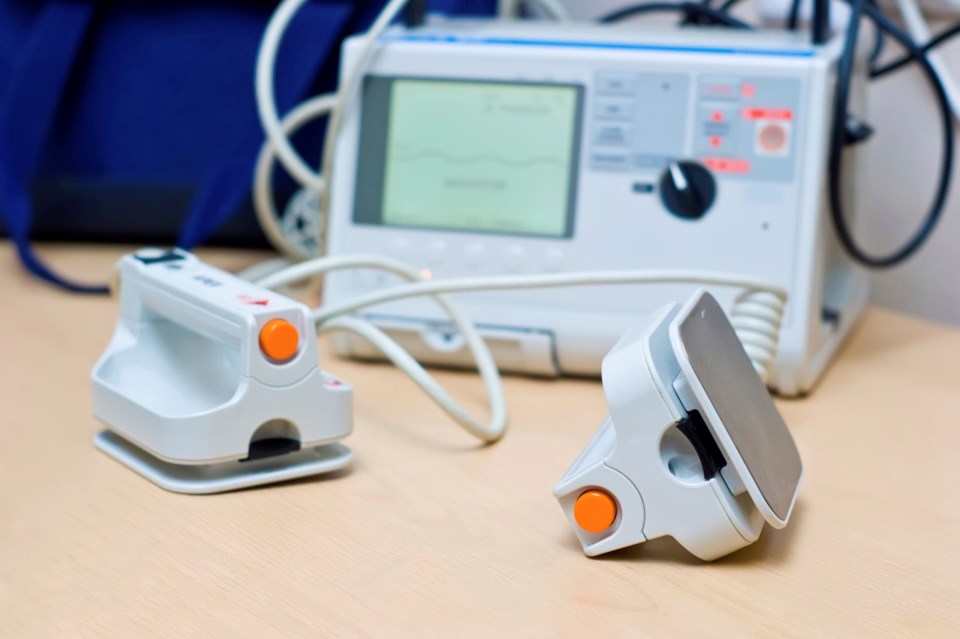A Burnaby woman who has worked for six years to make defibrillators as common in public as fire extinguishers doesn’t think new provincial funding announced recently goes far enough.
She wants a law.
Denise Giammaria’s husband – a fit, 43-year-old father of three – died of a sudden cardiac arrest during a hockey game six years ago.
Since then, the Gianfranco Giammaria Memorial Society has placed 64 life-saving Automated External Defibrillators (AEDs) in public places in Burnaby, Vancouver, West Vancouver, North Vancouver and Pitt Meadows.
In February 2013, the Heart and Stoke Foundation launched a parallel B.C. program and also began placing AEDs – matching $1 million in funding from the provincial government.
That funding was increased by another $1 million last month and will allow Heart and Stroke to place a total of 750 defibrillators in communities around the province over the next three years.
But for a province as big as B.C. that’s not enough for Giammaria, who has seen how ubiquitous the life-saving machines are in places with laws mandating their availability.
“We were in the States, and my kids counted 25 steps between one AED and another,” she said. “Then I found out it’s a law in the States.”
B.C. is late to the game when it comes to AEDs, according to Mark Collison, director of advocacy for the Heart and Stroke Foundation of B.C.
He said Ontario has already placed about 5,000 AEDs, spent more than $10 million and passed legislation protecting people from liability if they help someone using a defibrillator during an emergency.
Manitoba has gone one step further and passed a law that makes AEDs mandatory in certain kinds of venues.
That’s what Collison would like to see here, but when he first floated the idea of a public access to defibrillation program with provincial politicians in about 2007, he said it was “pushed off.”
Giammaria is frustrated with the lack of interest and said legislators would be more inclined to see how urgently a law is needed if they had had her experience.
“I need somebody in government office to have one of their family members go through what we went through,” she said.
Collison, however, is optimistic.
He said the extra $1 million in provincial funding announced this week bodes well for legislation.
“They obviously see the value,” he said.
And now that the Heart and Stroke Foundation’s Public Access to Defibrillation (PAD) program is off the ground, Collison said he will focus his efforts on convincing provincial politicians of the need for some kind of law, regulation or policy.
He favours Manitoba’s legislation because the B.C. government and the Heart and Stroke Foundation can’t ultimately fund all of the thousands of AEDs the province should have, he said.
“Manitoba didn’t get into funding AEDs and putting the program together,” he said. “What they did is they just made it law that certain venue types will have an AED – end of story.”
Another element the Heart and Stroke Foundation would like to see enshrined in some kind of law or regulation is protection for people who use a defibrillator on someone during an emergency so they can’t be sued if they acted in good faith.
Such protection already exists under the Good Samaritan Act, but the foundation would like to see it clarified, especially for off-duty health professionals and business owners who make AEDs available on their premises.
Finally, Heart and Stroke is pushing for rules that will ensure all AEDs are properly maintained and registered with 911 dispatch, so when a person calls in, a dispatcher can quickly tell him or her where to find the nearest AED.
To raise awareness about the importance of legislation for public defibrillators, the foundation has enlisted the help of advocates like Giammaria.
Her family’s story is included on a video presented to MLAs at the Legislature during AED Awarenes Day on April 3.
The breakfast event featuring the video was poorly attended, according to Collison, but a daylong Heart and Stroke Foundation health fair that followed saw about 100 MLAs and staffers asking questions and watching demonstrations, he said.
Collison has yet to find a political champion in Victoria for AED legislation, but with interest in public defibrillators growing, he said he hopes to find one soon.
If a law is eventually passed, Giammaria would like to see it named after her husband.
Collison said that would be a fitting tribute given how much the Gianfranco Giammaria Memorial Society has accomplished over the years.
“I think that would be a really nice legacy,” he said.



